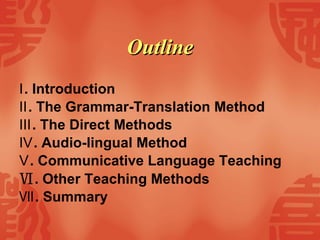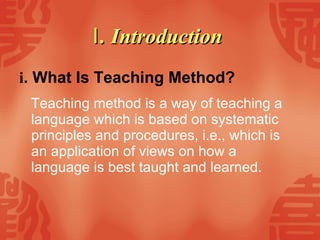Second Language Teaching Methods
- 1. Second/Foreign Language Teaching Methodologies Presented by: Li Shengxi Luan Lei Ma Huan Ye Min MA 03
- 2. Outline Ⅰ . Introduction Ⅱ . The Grammar-Translation Method Ⅲ . The Direct Methods Ⅳ . Audio-lingual Method Ⅴ . Communicative Language Teaching Ⅵ . Other Teaching Methods Ⅶ . Summary
- 3. Ⅰ . Introduction i . What Is Teaching Method? Teaching method is a way of teaching a language which is based on systematic principles and procedures, i.e., which is an application of views on how a language is best taught and learned.
- 4. ii. Seven Teaching Methodologies The Grammar-Translation Method The Direct Methods Audio-lingualism The Situational Language Teaching Communicative Language Teaching Humanistic Approaches Task-based Teaching
- 5. Ⅱ . The Grammar-Translation Method i . Background The grammar-translation method of foreign language teaching is one of the most tradi-tional methods, dating back to the late nine-teenth and early twentieth centuries. It was originally used to teach 'dead' languages (and literatures) such as Latin and Greek, and this may account for its heavy bias to-wards written work to the virtual exclusion of oral production.
- 6. ii. The Principal Characteristics Classes are taught in the students' mother tongue. Vocabulary is taught in the form of isolated word lists. Elaborate explanations of grammar are always provided. Reading of difficult texts is begun early in the course of study. Little attention is paid to the content of texts. Often the only drills are exercises in translating disconnected sentences. Little or no attention is given to pronunciation.
- 7. iii. Drawbacks No class time is allocated to allow students to produce their own sentences. There is often little contextualization of the grammar The type of error correction can be harmful to the students’ learning processes.
- 8. II. The Direct Method i. Background: a reaction to the grammar-translation approach in an attempt to integrate more use of the target language in instruction. ii. The Principal Characteristics Only use the target language in class. The learner should be actively involved in using the language in realistic everyday situations. Students are encouraged to think in the target language. First speaking is taught and then only reading and writing.
- 9. iii. Drawbacks L2 should be learned in way in which L1 was ac-quired - by total immersion technique. It rejects use of the printed word - but this objec-tion is illogical since L2 learner has already mas-tered his reading skills. Later disciples of Direct Method took it to extremes and refused to speak a single word of English in lessons. Also Direct Methodists failed to grade and struc-ture their materials adequately - no selection, grading or controlled presentation of vocabulary and structures.
- 10. iv. Strategies Using Direct Method Q & A: The teacher asks questions of any nature and the students answer. Dictation: The teacher chooses a grade appro-priate passage and reads the text aloud. Reading Aloud: Students take turn reading sec-tions of a passage, play or dialog out loud. Getting Students to Self-Correct: The teacher should have the students self-correct by offering them a choice between what they said and the proper pronunciation. Map Drawing
- 11. III. Audiolingual Method i. Background This method is based on the principles of behavior psychology. It adapted many of the principles and procedures of the Direct Method, in part as a re-action to the lack of speaking skills of the Reading Approach.
- 12. ii. The Method Characteristics Dependence on mimicry and memorization of set phrases Teaching structural patterns by means of repetitive drills No grammatical explanation Learning vocabulary in context Use of tapes and visual aids Focus on pronunciation Immediate reinforcement of correct responses
- 13. iii. Strategies Dialog Memorization Backward Build Up Transformation Drill Complete the Dialog Dictation Flashcards
- 14. Ⅳ . Communicative Language Teaching i. Background The communicative approach could be said to be the product of educators and linguists who had grown dissatisfied with the audio-lingual and grammar-translation methods of foreign language instruction. The origins of Communicative Language Teaching are to be found in the changes in the British languages teaching tradi-tion dating from the late 1960s. Interest in and development of communicative-style teaching mushroomed in the 1970s; authentic language use and classroom exchanges where students engaged in real communication with one another became quite popular.
- 15. ii. The Principal Characteristics Learner-Centered The role of the instructor in CLT is quite differ-ent from traditional teaching methods. In the traditional classroom, the teacher is in charge and "controls" the learning. In CLT the teacher serves as more of a facilitator, allowing stu-dents to be in charge of their own learning.
- 16. Communication Language is used for communication. For this reason, CLT makes use of communication to teach languages. CLT emphasizes real-life situ-ations and communica-tion in context. While gra-mmar is still important in the CLT classroom, the emphasis is on communi-cating a message .
- 17. Social Context CLT also stresses social and situational contexts of communi-cation. In CLT, stu-dents learn about language in social contexts, such as the difference between speaking with an elder and a peer.
- 18. iii. CLT and Multimedia Multimedia is an ideal way to teach lan-guage using CLT as the theory. It allows for realistic simulations of communicative situ-ations. Many such programs are games, such as "A la rencontre de Philipe" or "Who is Oscar Lake?". They place the learner in a situation in which understanding basic com-munication, and social and cultural contexts are vital to advancing in the game.
- 19. Ⅵ . Other Teaching Methods i. Humanism is described in applied linguistics as ‘language teaching respecting the integrity of learners, allowing for per-sonal growth and responsibility, taking psychological and affective factors into account, and representing “whole person learning”’. The roots of humanism in lan-guage teaching are various. One central one is the ‘discovery-learning’ movement.
- 20. Characteristics (take that of the Silent Way as an example) The students have to be fully alert to make the most of what the teacher says to play the major part in the learning. Various aids are used as simple pointers, or to make shapes, helping the learners de-duce the meanings for themselves. The method has many traditional aspects, including use of traditional structural sylla-buses.
- 21. ii. Task-based Teaching Task-based teaching has become a subject of keen contemporary interest, and different task-based approaches exist today. One underlying principle holds for all the approaches – to place the emphasis firmly on activities or tasks that learners do in class. One thing should be men-tioned is that, there are a number of features that will make tasks more or less difficult. So that we can progressively give our learners tasks where there are more and more things to think about, and consequently less and less attention available for form.
- 22. Ⅶ . Summary i. Comparison of Different Teaching Method Figure 1. Teacher & Learner Roles in Different Teaching Methods Relaxer True-Believer Auto-hypnotist Authority Figure Suggestopedia Guesser Immerser Actor Props User The Natural Approach Collaborator Whole Person Counselor Paraphraser Community Language Learning Commander Action Monitor Commander Action Monitor Total Physical Response Improviser Negotiator Needs Analyst Task Designer Communicative Language Teaching Pattern Practicer Accuracy Enthusiast Language Modeler Drill Leader Audio-lingualism Imitator Memorizer Context Setter Error Corrector Situational language Teaching Learner’s Roles Teacher’s Roles Method
- 23. ii. What's Now, What's Next? The future is always uncertain, and this is no less true in anticipating methodological directions in second language teaching than in any other field. Some current predictions assume the carrying on and refinement of current trends; others appear a bit more science-fiction-like in their vision. However, the future of L2 teaching methodologies, as yet not fully explored, is associated with what might be called a ‘cognitive approach to language learning’. Perhaps this cognitive, or information-processing approach is where the future lies.
- 24. The End























